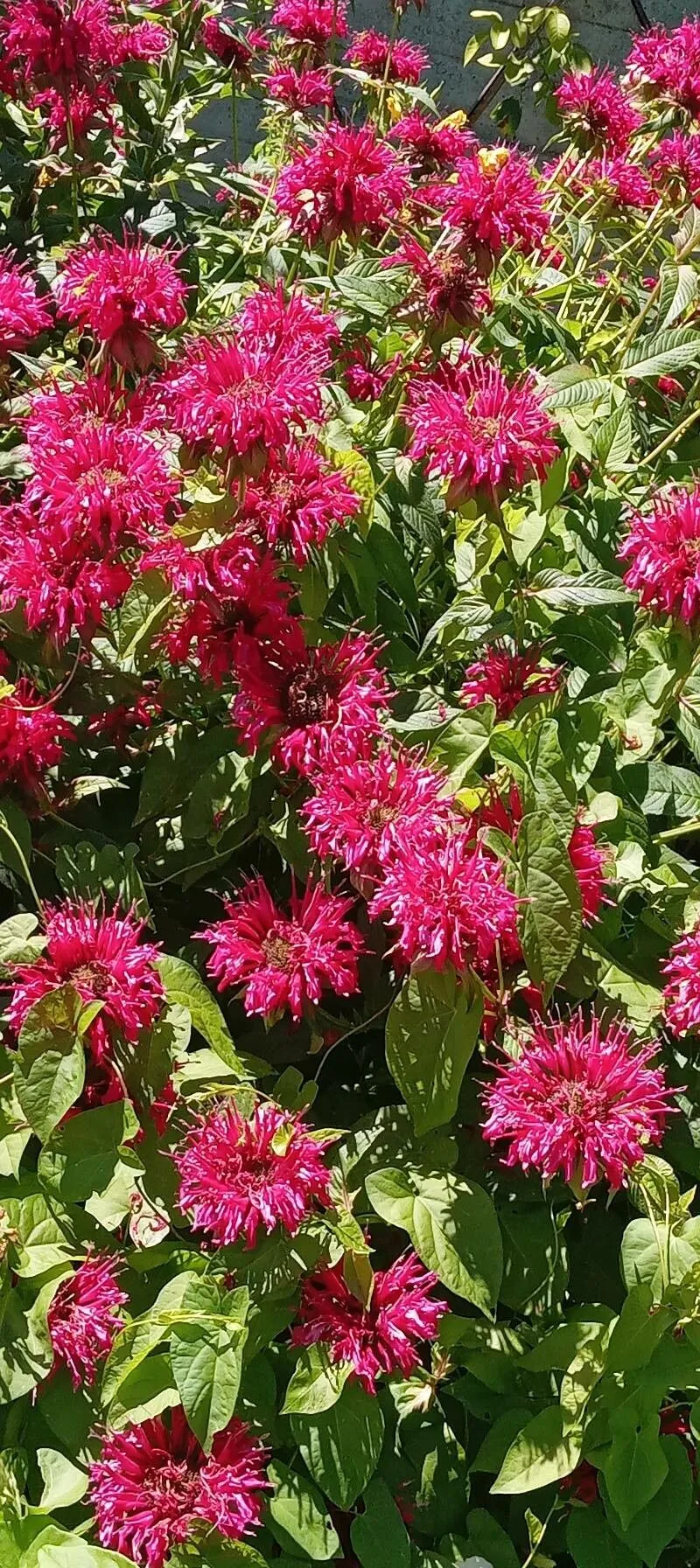
Author: L.
Bibliography: Sp. Pl.: 22 (1753)
Year: 1753
Status: accepted
Rank: species
Genus: Monarda
Vegetable: False
Observations: SE. Canada to E. U.S.A.
Oswego-tea, known scientifically as Monarda didyma, is a captivating perennial plant native to southeastern Canada and the eastern United States. It belongs to the Lamiaceae family, which is renowned for its aromatic herbs.
First documented in 1753 by the botanist Linnaeus, who listed it in his seminal work Species Plantarum, Oswego-tea has been cherished for both its ornamental beauty and its practical uses. The plant is typically found in moist, shaded environments such as woodlands and along streams, thriving in the temperate climate of its native regions.
Oswego-tea boasts a striking appearance, with bright red, tubular flowers that bloom in dense, showy clusters at the top of its stems. These vibrant blossoms not only add a splash of color to gardens but also attract a variety of pollinators, including bees, butterflies, and hummingbirds, owing to their rich nectar.
The leaves of Monarda didyma are aromatic and have been historically utilized by Native American tribes for their medicinal properties. When crushed, the leaves release a fragrant scent reminiscent of bergamot, which has made it a popular choice for herbal teas and potpourri. This characteristic has also earned it the nickname “Bee Balm.”
Gardeners appreciate Oswego-tea for its hardiness and ease of cultivation. It prefers full sun to partial shade and well-drained soil, although it can tolerate a range of conditions if necessary. It grows to a height of about two to four feet, making it an excellent choice for the middle or back portions of flower beds.
Whether admired for its beauty, appreciated for its aroma, or cultivated for its ecological benefits, Oswego-tea stands out as a versatile and beloved plant. Its historical significance and continued popularity underscore its status as a garden favorite.
Eng: beebalm, bergamot, fragrantbalm, mountain-mint, oswego tea, oswego-tea, scarlet beebalm, fragrant balm, mountain mint
Deu: scharlach-goldmelisse, scharlach-indianernessel, scharlach-monarde
Por: monarda
Ces: monarda dvojmocná
Fra: monarde écarlate, monarde pourpre
Swe: röd temynta, blodröd temynta
Nld: bergamotplant
Nno: hestemynte
Nob: hestemynte, etasjeblomst
En: Oswego-tea, Beebalm, Bergamot, Mountain-mint, Fragrantbalm, Scarlet beebalm, Fragrantblam, Oswego tea, Fragrant balm, Mountain mint
Ar: مونردة مزدوجة
Bg: Червен бергамот
Zh: 美国薄荷, 美國薄荷
Cs: Zavinutka podvojná, Monarda dvojmocná
Da: Heste Monarda, Dobbelt Hestemynte
Nl: Bergamotplant
Fi: Punaväriminttu
Fr: Monarde, Monarde écarlate, Monarde pourpre
De: Scharlach-Indianernessel, Indianernessel, Scharlach-Monarde, Goldmelisse, Scharlach-Goldmelisse
He: ברגמוט
Hu: Vörös méhbalzsam
Mk: Пчелина мелемка
No: Hestemynte
Nb: Hestemynte, Etasjeblomst
Nn: Hestemynte
Pl: Pysznogłówka dwoista, Pysznogłówka szkarłatna
Pt: Monarda
Ru: Монарда двойчатая
Sv: Röd temynta, Blodröd temynta
Zh-tw: 美國薄荷
Zh-hant: 蜂香薄荷
Uk: Монарда двійчаста
Cy: Bergamot
Taken Jul 13, 2022 by Fabrice Rubio (cc-by-sa)
Taken Jul 7, 2021 by Reynold Chollet (cc-by-sa)
Taken Mar 29, 2020 by Benoit Pellizzari (cc-by-sa)
Taken Jul 21, 2017 by Amy Wagner (cc-by-sa)
Taken Jul 20, 2018 by Mireille vd Sande (cc-by-sa)
Taken Jul 2, 2022 by William Coville (cc-by-sa)
Taken May 14, 2021 by Julie Cloutier (cc-by-sa)
Taken Jun 19, 2022 by Louwrien Buisman (cc-by-sa)
Taken Nov 13, 2021 by Jani Zadrgal (cc-by-sa)
Taken Nov 13, 2021 by Jani Zadrgal (cc-by-sa)
Taken Jun 25, 2022 by herbalis Herba (cc-by-sa)
Taken Jul 28, 2022 by Kai Best (cc-by-sa)
Taken Jul 2, 2022 by William Coville (cc-by-sa)
Taken Aug 6, 2019 by Karim Amziane (cc-by-sa)
Taken Jul 13, 2022 by Fabrice Rubio (cc-by-sa)
Taken Jul 13, 2019 by kelly (cc-by-sa)
Taken Jul 5, 2012 by Tela Botanica − Yoan MARTIN (cc-by-sa)
Taken Jul 9, 2021 by Roxanne B (cc-by-sa)
Taken Nov 13, 2021 by Jani Zadrgal (cc-by-sa)
Taken Nov 13, 2021 by Jani Zadrgal (cc-by-sa)
Taken Aug 24, 2020 by Laurie Smith (cc-by-sa)
Taken Jun 19, 2022 by Josh Winn (cc-by-sa)
Taken Jul 5, 2012 by Tela Botanica − Yoan MARTIN (cc-by-sa)
Taken Jun 30, 2011 by Tela Botanica − Yoan MARTIN (cc-by-sa)
Taken Jul 5, 2012 by Tela Botanica − Yoan MARTIN (cc-by-sa)
Taken Jul 21, 2022 by Nuala Power (cc-by-sa)
Taken May 18, 2022 by David David (cc-by-sa)
Taken Jul 4, 2021 by s n (cc-by-sa)
Taken May 29, 2022 by d A (cc-by-sa)
Taken Jul 5, 2021 by D M (cc-by-sa)
© copyright of the Board of Trustees of the Royal Botanic Gardens, Kew.
© copyright of the Board of Trustees of the Royal Botanic Gardens, Kew.
© copyright of the Board of Trustees of the Royal Botanic Gardens, Kew.
Growth habit: Forb/herb
Family: Myrtaceae Author: (F.Muell.) K.D.Hill & L.A.S.Johnson Bibliography: Telopea 6: 402 (1995) Year: 1995 Status:…
Family: Rubiaceae Author: Pierre ex A.Froehner Bibliography: Notizbl. Bot. Gart. Berlin-Dahlem 1: 237 (1897) Year:…
Family: Sapindaceae Author: Koidz. Bibliography: J. Coll. Sci. Imp. Univ. Tokyo 32(1): 38 (1911) Year:…
Family: Asteraceae Author: A.Gray Bibliography: Pacif. Railr. Rep.: 107 (1857) Year: 1857 Status: accepted Rank:…
Family: Fabaceae Author: Medik. Bibliography: Vorles. Churpfälz. Phys.-Ökon. Ges. 2: 398 (1787) Year: 1787 Status:…
Family: Aspleniaceae Author: (Cav.) Alston Bibliography: Bull. Misc. Inform. Kew 1932: 309 (1932) Year: 1932…